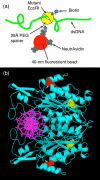Fluorescent marker for direct detection of specific dsDNA sequences
- PMID: 19908852
- PMCID: PMC2811260
- DOI: 10.1021/ac9019895
Fluorescent marker for direct detection of specific dsDNA sequences
Abstract
We have created a fluorescent marker using a mutant EcoRI restriction endonuclease (K249C) that enables prolonged, direct visualization of specific sequences on genomic lengths of double-stranded (ds) DNA. The marker consists of a biotinylated enzyme, attached through the biotin-avidin interaction to a fluorescent nanosphere. Control over biotin position with respect to the enzyme's binding pocket is achieved by biotinylating the mutant EcoRI at the mutation site. Biotinylated enzyme is incubated with dsDNA and NeutrAvidin-coated, fluorescent nanospheres under conditions that allow enzyme binding but prevent cleavage. Marker-laden DNA is then fluorescently stained and stretched on polylysine-coated glass slides so that the positions of the bound markers along individual DNA molecules can be measured. We demonstrate the marker's ability to bind specifically to its target sequence using both bulk gel-shift assays and single-molecule methods.
Figures





Similar articles
-
Changing the target base specificity of the EcoRV DNA methyltransferase by rational de novo protein-design.Nucleic Acids Res. 2001 Aug 1;29(15):3137-44. doi: 10.1093/nar/29.15.3137. Nucleic Acids Res. 2001. PMID: 11470870 Free PMC article.
-
Asymmetric DNA methylation by dimeric EcoP15I DNA methyltransferase.Biochimie. 2016 Sep-Oct;128-129:70-82. doi: 10.1016/j.biochi.2016.07.006. Epub 2016 Jul 13. Biochimie. 2016. PMID: 27422119
-
Sequence-specific recognition of cytosine C5 and adenine N6 DNA methyltransferases requires different deformations of DNA.Proc Natl Acad Sci U S A. 1996 Jul 23;93(15):7618-22. doi: 10.1073/pnas.93.15.7618. Proc Natl Acad Sci U S A. 1996. PMID: 8755524 Free PMC article.
-
An EcoRI-RsrI chimeric restriction endonuclease retains parental sequence specificity.Biochim Biophys Acta. 2007 May;1774(5):583-94. doi: 10.1016/j.bbapap.2007.02.011. Epub 2007 Mar 14. Biochim Biophys Acta. 2007. PMID: 17442645
-
Surface-tethered DNA complexes for enhanced gene delivery.Bioconjug Chem. 2002 May-Jun;13(3):621-9. doi: 10.1021/bc015575f. Bioconjug Chem. 2002. PMID: 12009954
Cited by
-
Labeling DNA for single-molecule experiments: methods of labeling internal specific sequences on double-stranded DNA.Nanoscale. 2011 Aug;3(8):3027-39. doi: 10.1039/c1nr10280j. Epub 2011 Jul 6. Nanoscale. 2011. PMID: 21734993 Free PMC article. Review.
-
Sensitive Cu2+-Cu2+ distance measurements in a protein-DNA complex by double-quantum coherence ESR.J Phys Chem B. 2013 May 23;117(20):6227-30. doi: 10.1021/jp4037149. Epub 2013 May 10. J Phys Chem B. 2013. PMID: 23631829 Free PMC article.
-
Restriction Endonuclease-Based Assays for DNA Detection and Isothermal Exponential Signal Amplification.Sensors (Basel). 2020 Jul 11;20(14):3873. doi: 10.3390/s20143873. Sensors (Basel). 2020. PMID: 32664471 Free PMC article.
-
Toward single-molecule optical mapping of the epigenome.ACS Nano. 2014 Jan 28;8(1):14-26. doi: 10.1021/nn4050694. Epub 2013 Dec 20. ACS Nano. 2014. PMID: 24328256 Free PMC article.
-
Insights into copper coordination in the EcoRI-DNA complex by ESR spectroscopy.Mol Phys. 2014 Dec 1;112(24):3173-3182. doi: 10.1080/00268976.2014.934313. Mol Phys. 2014. PMID: 25750461 Free PMC article.
References
Publication types
MeSH terms
Substances
Grants and funding
LinkOut - more resources
Full Text Sources
Other Literature Sources

